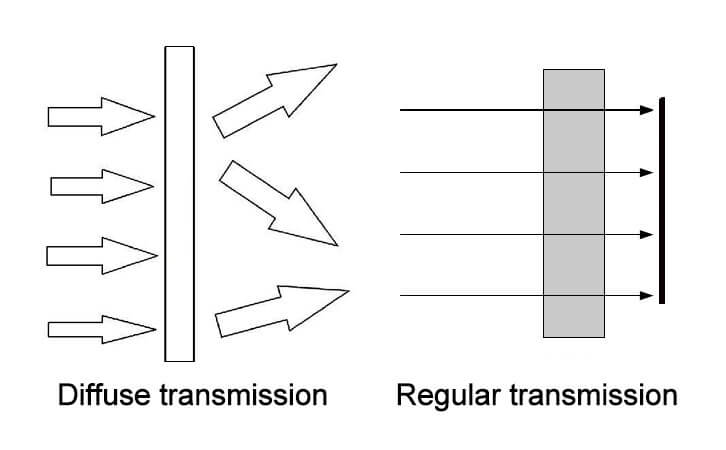About the Selection of LS116 and LS117 Light Transmittance Meter
Linshang Technology has a variety of transmission meters and light transmittance meters designed for transparent and uniform materials which adopts the principle of regular transmission, including the high-precision light transmittance meter LS116. However, this principle does not apply to the transmittance test of frosted materials, opalescent materials, and other translucent materials.
The following figure tests a piece of opalescent LDPE material (high pressure polyethylene). The transmittance data on LS116 is only 52.08%, and the light transmittance displayed on LS117 light transmittance meter can reach 93.768%. The difference between the two transmittance data is about 40%.
Of course, the data of LS117 light transmittance meter is accurate. So what makes the difference? Firstly we need to understand a few related nouns.
Transmittance: Transmittance is a physical vocabulary used to indicate the ability of light to pass through a medium, as a percentage of the luminous flux through a transparent or translucent medium and its incident light flux.
Refraction of light: When light is obliquely incident from one medium to another, the direction of light propagation changes, causing the light to deflect at the junction of different media.
Regular transmission: The phenomenon that the light passes through a uniform material with smooth surface is deflected at the same angle is called the regular transmission of the material.
Diffuse transmission: When light passes through a material with a rough surface or uneven internal medium (such as frosted glass, opal glass), the transmitted light will spread out in many directions because the light will appear at different angles on the rough surface of the medium. The light will also produces refraction at the interface of the medium of uneven material. This phenomenon is called diffuse transmission of materials.

Question 1. How is the transmittance data calculated?
The data of the LS116 and LS117 light transmittance meters are obtained by dividing the transmitted luminous flux by the incident luminous flux (original luminous flux). The light sources built into both LS116 and LS117 are 380-760nm white light. The light transmittance meter is mainly composed of a light source and a receiver. After the power is turned on, the parallel light emitted by the light source is completely received by the receiver, and the instrument obtains the incident light flux value. Next when we place a sample between the light source and the receiver, the receiver cannot receive all the light emitted by the light source due to the different ability of different materials to absorb light. At this time, the luminous flux of the transmitted material is divided by the original luminous flux to obtain the material’s light transmittance.
Question 2: Why is the transmittance obtained by the LS116 and LS117 different?
The light transmittance of LS116 can only receive the light that is regularly transmitted after passing through the material, so it is suitable for the transmittance test of transparent glass, transparent film and other materials. If the frosted glass with uneven surface is tested with LS116, since the angle between the light and the uneven surface is different, after passing through the glass, the light will be refracted at different angles, and the light will spread in different directions and cannot be completely received by the receiver. The received luminous flux will be smaller than the actual luminous flux, so the measured transmittance data will be smaller than actual value. But LS117 adopts the diffuse transmission principle. The receiver can receive all the light after passing through the material, so it can also be used to measure the transmittance of materials such as frosted glass and opal glass.
Question 3: Can I use LS116 to measure frosty or milky white materials?
At present, a part of customers are using the LS116 light transmittance meter to measure the light transmittance of some frosty and opalescent materials. This is not entirely undesirable.
If the user does not have strict requirements on the accuracy of the data, the test data of the LS116 can be used to check the uniformity of the transmittance of the material, but the data is for reference only and has no practical significance. If you need to get the accurate transmittance of a milky white material, and even require the data can pass the inspection of authoritative metrological institute, we still recommend the customer to purchase the LS117 light transmittance meter.
- Linshang Insulated Glass Unit Measuring Tools
- Spectacle lens anti-blue light detection---blue-violet light transmittance meter
- Measurement of Optical Density
- Difference of LS116 Transmission & LS117 OD Meter
- Difference between LS116 and LS117 Light Transmittance Meter
- What’s the Difference Between Point Light and Parallel Light Transmittance Meter
